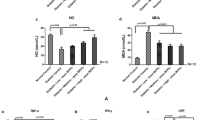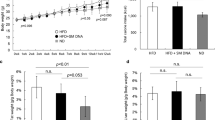Abstract
To fight against metabolic disorders such as insulin resistance, new alimentary behaviors are developed. For instance, hyperproteined, gluten-free, or collagen-enriched diets could be preconized in order to reduce the consequences of obesity. In this aim, this study evaluates the potential effects of warm sea fish collagen peptides (Naticol®) on representative metabolic and inflammatory parameters. For that, male C57Bl6/J mice fed with either a chow- (CD) or high-fat diet (HFD) were submitted or not to specific collagen peptides in drinking water (4 g/kg bw/d) for 20 weeks. Weight, body composition, glucose tolerance, and insulin sensitivity were followed up. Effects of fish collagen peptides on various blood parameters reflecting the metabolism status were also measured (free fatty acids, triglycerides, cholesterol, hormones) together with adipocyte inflammation. Results showed that HFD-fed mice supplemented by fish collagen peptides exhibited a significant lower increase in body weight as soon as the twelfth week of treatment whereas no effect of the peptide was observed in CD fed mice. In line with this result, a weaker increase in fat mass in HFD-fed mice supplemented with Naticol® at both 9 and 18 weeks of treatment was also observed. In spite of this resistance to obesity promoted by fish collagen peptides treatment, no difference in glucose tolerance was found between groups whereas mice treated with Naticol® exhibited a lower basal glycemia. Also, even if no effect of the treatment on adipocyte lipolysis was found, a decrease of inflammatory cytokines was retrieved in collagen-supplemented group arguing for a potential better insulin sensitivity. Altogether, these results need to be completed but are the first describing a benefic role of warm sea fish collagen peptides in a context of metabolic disease paving the route for a potential utilization in human obesity-associated disorders.





Similar content being viewed by others
References
Gloyn AL, McCarthy MI (2008) Genetics: how the UKPDS contributed to determining the genetic landscape of type 2 diabetes. Diabet Med 25(Suppl 2):35–40
Hu FB, Manson JE, Stampfer MJ, Colditz G, Liu S, Solomon CG, Willett WC (2001) Diet, lifestyle, and the risk of type 2 diabetes mellitus in women. N Engl J Med 345:790–797
Kelley DE, Wing R, Buonocore C, Sturis J, Polonsky K, Fitzsimmons M (1993) Relative effects of calorie restriction and weight loss in noninsulin-dependent diabetes mellitus. J Clin Endocrinol Metab 77:1287–1293
Knowler, Barrett-Connor, Fowler, Hamman, Lachin, Walker, Nathan, Diabetes Prevention Program Research (2002) Reduction in the incidence of type 2 diabetes with lifestyle intervention or metformin. N Engl J Med 346:393–403
Lavigne C, Tremblay F, Asselin G, Jacques H, Marette A (2001) Prevention of skeletal muscle insulin resistance by dietary cod protein in high fat-fed rats. Am J Physiol Endocrinol Metab 281:E62–E71
McKnight JR, Satterfield MC, Jobgen WS, Smith SB, Spencer TE, Meininger CJ, McNeal CJ, Wu G (2010) Beneficial effects of L-arginine on reducing obesity: potential mechanisms and important implications for human health. Amino Acids 39:349–357
Meigs JB, Wilson PW, Fox CS, Vasan RS, Nathan DM, Sullivan LM, D’Agostino RB (2006) Body mass index, metabolic syndrome, and risk of type 2 diabetes or cardiovascular disease. J Clin Endocrinol Metab 91:2906–2912
Sousa SC, Vazquez JA, Perez-Martin RI, Carvalho AP, Gomes AM (2017) Valorization of by-products from commercial fish species: extraction and chemical properties of skin gelatins. Molecules 22:E1545
Spranger J, Kroke A, Mohlig M, Hoffmann K, Bergmann MM, Ristow M, Boeing H, Pfeiffer AF (2003) Inflammatory cytokines and the risk to develop type 2 diabetes: results of the prospective population-based European prospective investigation into Cancer and Nutrition (EPIC)-Potsdam Study. Diabetes 52:812–817
Stumvoll M, Goldstein BJ, van Haeften TW (2005) Type 2 diabetes: principles of pathogenesis and therapy. Lancet 365:1333–1346
Tilg H, Moschen AR (2008) Inflammatory mechanisms in the regulation of insulin resistance. Mol Med 14:222–231
Tremblay F, Lavigne C, Jacques H, Marette A (2003) Dietary cod protein restores insulin-induced activation of phosphatidylinositol 3-kinase/Akt and GLUT4 translocation to the T-tubules in skeletal muscle of high-fat-fed obese rats. Diabetes 52:29–37
Tuomilehto J, Lindstrom J, Eriksson JG, Valle TT, Hamalainen H, Ilanne-Parikka P, Keinanen-Kiukaanniemi S, Laakso M, Louheranta A, Rastas M, Salminen V, Uusitupa M, Finnish Diabetes Prevention Study (2001) Prevention of type 2 diabetes mellitus by changes in lifestyle among subjects with impaired glucose tolerance. N Engl J Med 344:1343–1350
Van Gaal LF, Wauters MA, De Leeuw IH (1997) The beneficial effects of modest weight loss on cardiovascular risk factors. Int J Obes Relat Metab Disord 21(Suppl 1):S5–S9
Veldhorst MA, Nieuwenhuizen AG, Hochstenbach-Waelen A, van Vught AJ, Westerterp KR, Engelen MP, Brummer RJ, Deutz NE, Westerterp-Plantenga MS (2009) Dose-dependent satiating effect of whey relative to casein or soy. Physiol Behav 96:675–682
Vereecken CA, Todd J, Roberts C, Mulvihill C, Maes L (2006) Television viewing behaviour and associations with food habits in different countries. Public Health Nutr 9:244–250
Vidal J (2002) Updated review on the benefits of weight loss. Int J Obes Relat Metab Disord 26(Suppl 4):S25–S28
Wannamethee SG, Shaper AG, Walker M (2005) Overweight and obesity and weight change in middle aged men: impact on cardiovascular disease and diabetes. J Epidemiol Community Health 59:134–139
Wing RR, Blair EH, Bononi P, Marcus MD, Watanabe R, Bergman RN (1994) Caloric restriction per se is a significant factor in improvements in glycemic control and insulin sensitivity during weight loss in obese NIDDM patients. Diabetes Care 17:30–36
Xiang AH, Peters RK, Kjos SL, Goico J, Ochoa C, Marroquin A, Tan S, Hodis HN, Azen SP, Buchanan TA (2004) Pharmacological treatment of insulin resistance at two different stages in the evolution of type 2 diabetes: impact on glucose tolerance and beta-cell function. J Clin Endocrinol Metab 89:2846–2851
Zhu CF, Peng HB, Liu GQ, Zhang F, Li Y (2010) Beneficial effects of oligopeptides from marine salmon skin in a rat model of type 2 diabetes. Nutrition 26:1014–1020
Zoetendal EG, Vaughan EE, de Vos WM (2006) A microbial world within us. Mol Microbiol 59:1639–1650
Acknowledgements
We gratefully acknowledge the animal facilities and phenotypage staff (Inserm US006) and the company Weishardt for providing fish collagen peptides, Naticol®.
Funding
This study is financially supported by the Région Midi-pyrénées.
Author information
Authors and Affiliations
Corresponding author
Rights and permissions
About this article
Cite this article
Astre, G., Deleruyelle, S., Dortignac, A. et al. Diet-induced obesity and associated disorders are prevented by natural bioactive type 1 fish collagen peptides (Naticol®) treatment. J Physiol Biochem 74, 647–654 (2018). https://doi.org/10.1007/s13105-018-0650-0
Received:
Accepted:
Published:
Issue Date:
DOI: https://doi.org/10.1007/s13105-018-0650-0




